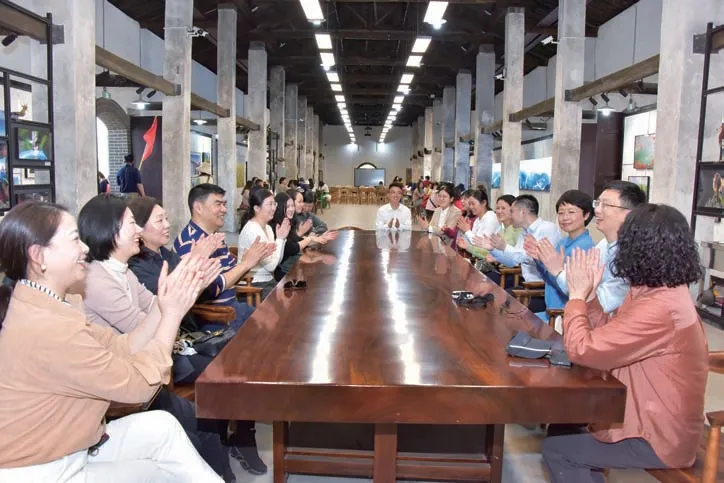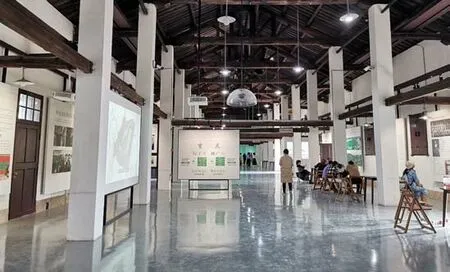广阳坝机场遗址抗战时的重庆空中门户,如今的公共文化空间
2022-04-23杨艳
文 图/本刊记者 杨艳
暮春四月,草长莺飞。广阳岛上,山、水、林、田、湖、草相映成趣,广阳岛国际会议中心等项目正如火如荼建设……呈现出一派欣欣向荣的景象。2018年,重庆市正式规划广阳岛为“长江生态文明创新试验区”,集中展示生态文明试验成果,为大家提供一个生态休闲观光好去处。
In early April, the grass is tall and the birds are flying high. On Guangyang Island, hills, rivers, forests, fields, lakes, and grass form a delightful contrast,and the Guangyang Island International Convention Center and other projects are under construction in full swing...... Everything is taking on a new and thriving look. In 2018, Chongqing officially announces Guangyang Island as the “Pilot Zone for Eco-civilization Innovation on the Yangtze River”, focusing on presenting the results of eco-civilization pilot projects and creating an ideal destination for leisure and sightseeing.

长江上游第一大“江心岛”广阳岛上的广阳营。

广阳坝机场遗址群。

广阳坝机场中国空军曾使用的1-16战斗机。(资料图)
除了自然景观,广阳岛上还有国内保存最完整、遗迹种类和数量最多、面积最大的抗战机场遗址,包括美军招待所、油库、碉堡、士兵营房、抗战题刻等值得参观。
广阳岛古称广德屿、广阳洲,民间通称广阳坝。1930年2月11日,重庆历史上第一架飞机正式起飞,起飞地点正是位于南岸区峡口镇广阳岛上的广阳坝机场。
广阳坝机场是重庆主城最早修建的机场。1929年8月,时任四川军务善后督办兼国民革命军第21军军长刘湘,决定在广阳坝修建机场。抗战时期,中国空军在重庆设立第一路司令部,负责战时首都重庆的防空作战任务。其中,保卫重庆的中国空军主要驻防广阳坝、白市驿和梁山(今重庆梁平)三大机场。广阳坝机场因所处江面中央,地形相对平坦宽阔,有铜锣山、明月山作为天然屏障,进可攻、退可守,成为抗战时期保卫重庆空中安全的门户。
In addition to the natural landscape, Guangyang Island is also home to the most complete and the largest area of wartime airfield heritage sites in China, with the most diverse and the largest number of relics, including the U.S. Army hotel,oil depot, bunkers, barracks, wartime inscriptions, and other sites worth visiting.
Guangyang Island was formerly known as Guangde(Islet) and Guangyang(offshore bank) and is commonly known as Guangyang(Dam) among the locals. In history, the first plane of Chongqing took off on February 11, 1930 from the Guangyangba Airport on Guangyang Island in Xiakou Town, Nan’an District.
Guangyangba Airport was the first airport in the main urban area of Chongqing. In August 1929, Liu Xiang, then the Sichuan Military Logistics Supervisor and commander of the 21Army of the National Revolutionary Army,decided to build an airport in Guangyang Dam. During the War of Resistance against Japanese Aggression, the Chinese Air Force set up the First Route Command in Chongqing, which was responsible for air defense operations in the wartime capital of Chongqing. Among them, the Chinese air force defending Chongqing was mainly stationed at the three major airports in Guangyangba,Baishiyi, and Liangshan (now Liangping, Chongqing). Guangyangba Airport was the wartime gateway guarding Chongqing's airspace safety as it was located in the middle of the Yangtze River, where the terrain was relatively flat and wide. And with Tongluo Mountain and Mingyue Mountain as natural barriers, it could be defended when attacked and also conduct proactive attacks.
In 1937, when the War of Resistance against Japanese Aggression broke out,to strengthen the air defense of Chongqing, the National Government drafted 12,000 workers to expand the Guangyangba Airport. With primitive tools, people cut all the rolling hills at the eastern end of Guangyang Island into flat land, and at
1937年,抗日战争全面爆发,为了加强重庆的防空力量,国民政府征工12000人,扩建广阳坝机场。人们用最原始的工具,将广阳岛东端的连绵山丘全部削成平地,同时扩建的还有军营、机修库、美军招待所、指挥部、碉堡等建筑设施。
广阳坝机场成为大后方重要的军事机场之一,在抗战中发挥了重要作用。以重庆空战期间,中国空军在空中负责对日作战的最高指挥官—地下党员郑少愚为代表的一批优秀飞行员,曾在广阳坝机场浴血奋战,构筑起重庆坚固的空中防线。
1939年初,中国空军第五大队第27中队进驻广阳坝机场,后中国空军王牌驱逐机大队第四大队进驻,负责重庆的防空作战任务,多次迎击日机空袭。这支队伍中,不少飞行员是来自南洋的华侨。此外,岛内还有苏联和美国的援华志愿航空队。
In 1937, when the War of Resistance against Japanese Aggression broke out,to strengthen the air defense of Chongqing, the National Government drafted 12,000 workers to expand the Guangyangba Airport. With primitive tools, people cut all the rolling hills at the eastern end of Guangyang Island into flat land, and at the same time expanded the barracks, mechanic depot, U.S. Army hotel, command headquarters, bunkers, and other building facilities.
Guangyangba Airport became one of the important military airfields in the Great Rear Area and played an important role in the war. During the air battles in Chongqing, a group of prominent pilots, represented by Zheng Shaoyu, an underground CPC member and the top commander of the Chinese Air Force in charge of the air battles against Japan, fought bloodily at Guangyangba Airport and truly built a solid air defense barrier in Chongqing.
In early 1939, the 27Squadron of the 5Brigade of the Chinese Air Force was stationed at Guangyangba Airport, and later the 4Brigade of the Chinese Air Force, a renowned and prominent Brigade, was stationed to take charge of the air defense missions in Chongqing and fought heroically during the Japanese air raids many times. Many of the pilots in this group were overseas Chinese nationals from South Asia. In addition, there were also Soviet and American volunteer air units aiding China stationed on the island.
Now, 92 years have passed. Strolling down the long corridors inside the rebuilt Guangyang Camp, one can enjoy the green and vibrant grasslands in front of the buildings. The sun shines on the renovated walls, a peaceful and quiet place.
Guangyang Camp was once the barracks of Guangyangba Airport. Barrack 1 and 2 are the two largest barracks in the entire Guangyangba Airport heritage site, which are in situ conservation and restoration buildings and have become an exhibition hall. It is made up of a hip-and-gable roof with small green tiles,brick column bearing, rooms divided by rammed earth walls, wooden doors and windows, and outer corridors around the main body of the building. The architecture style is square and rigorous, simple but dignified.

1号营展陈长江流域生态影像展,作为集娱乐、休闲、会议、活动等功能于一体的公共文化艺术空间开放。摄影/唐安冰
如今,九十多年过去了。漫步在重建的广阳营长长的走廊,屋前绿草茵茵,生机勃发。阳光照在翻新的墙面上,一片祥和宁静。
广阳营曾是广阳坝机场的营房。1、2号营房是整个广阳坝机场抗战遗址群中最大的两座营房,为原址保护修缮建筑,已成为科普性质的展馆。歇山式小青瓦屋顶,砖柱承重,夯土墙分割开间,木质门窗,环建筑主体四周设置贯通式外廊。整体望去,方正严谨,朴实厚重。
往室内走,墙壁上张贴着营房的历史照片,再现了当年这座“英雄之岛”的历史事迹。3号营由6个独立单间组合而成,为巴渝民居山墙风格立面,小巧精致。4号营包含两个院落,双院落之间由内部廊道连接,方正对称,古风典雅。
1949年后,广阳坝机场由川东军区接管。广阳坝机场在经历抗战的浴血同盟之后,曾作为重庆市体育运动委员会航空俱乐部所在地,为重庆培育航空航天人才。俱乐部撤销后,转为市体委训练基地,其中部分土地经市政府批准开垦为农场。
据统计,广阳岛上现存机场遗址共28处,其中碉堡8个、士兵营房8栋、美军招待所2个、油库6个、防空洞2个、发电房1个,通往广阳岛的钢筋混凝土桥梁1座。遗址群结构完整,保存较好,是重庆市为数不多的较完整的抗战军事设施,对研究抗战历史具有重大意义。


2号营现为广阳岛规划展陈。
Entering indoors, photos of the barracks in the past are exhibited on the walls, recreating the historical events of this “Island of Heroes”. Camp No. 3 is a combination of six independent single rooms, with a delicate and exquisite façade in the style of the Bayu folk house. Camp No. 4 contains two courtyards connected by an internal corridor, which is square and symmetrical, with an elegant ancient style.
After 1949, Guangyangba Airport was taken over by the Eastern Sichuan Military Region. As an Allied power that fought bravely in the Anti-Japanese Aggression War, Guangyangba Airport later served as the location of the Aviation Club of the Chongqing Sports Commission, which nurtured aerospace talents for Chongqing. After the club was abolished, it was turned into a training base for the Chongqing Sports Commission, and part of the land was reclaimed as a farm with the approval of the municipal government.
There are currently 28 existing airfield heritage sites on Guangyang Island,including 8 bunkers, 8 soldiers’ barracks, 2 U.S. Army hotels, 6 oil depots,2 air defense shelters, 1 power generation house, and 1 reinforced concrete bridge connecting Guangyang Island with land. The structure of the site group is complete, well preserved, and as one of the few complete wartime military facilities in Chongqing, it bears great significance to the study of wartime history.
History roots deeply and continues to grow on this ecological island, and culture presents treasures that shine in the embrace of breathtaking sceneries. At present, with elaborate planning and effective conservation, Guangyang Camp is cleverly utilized as a destination for Guangyangba’s historical and cultural attractions, as well as an ecological island for leisure and experiences. It provides functions including entertainment, leisure, convention, and other activities,providing a cultural and artistic space for the public. In recent years, national expert seminars on the construction of ecological facilities and the Great River Civilization Museum, as well as various thematic studies such as the “Bayu Nature” science popularization initiative have been held in Guangyang Camp.Guangyang Island is truly taking up the responsibilities of new historical missions and drawing a beautiful picture for the future with renewed vitality.
